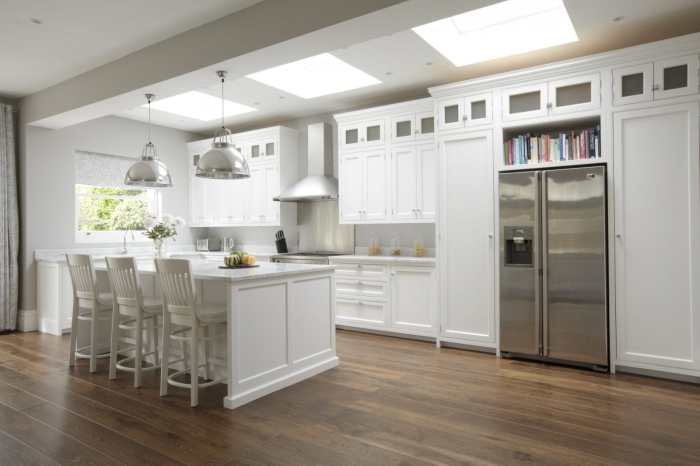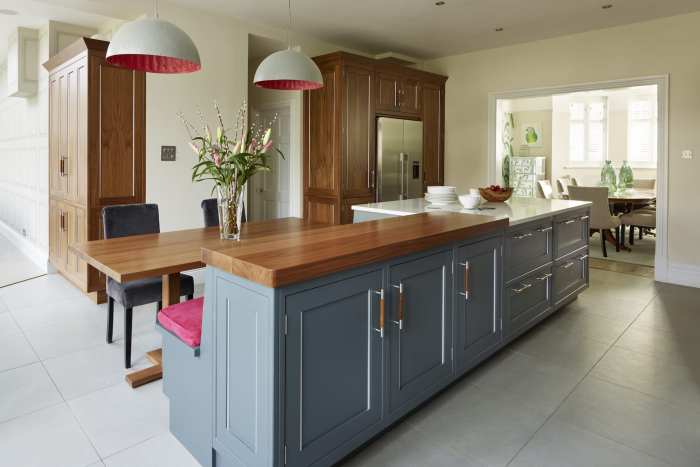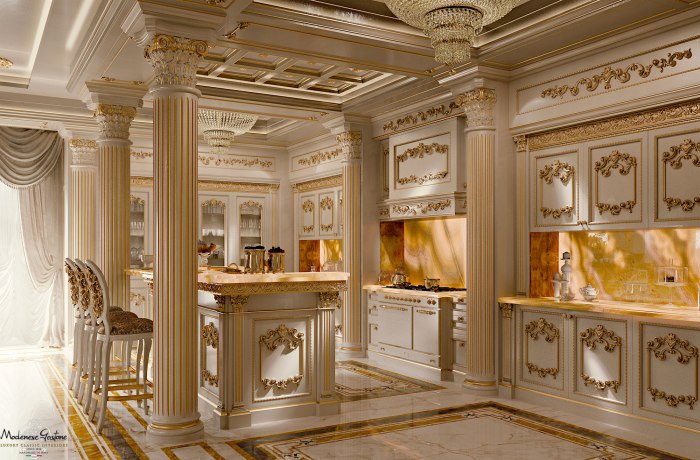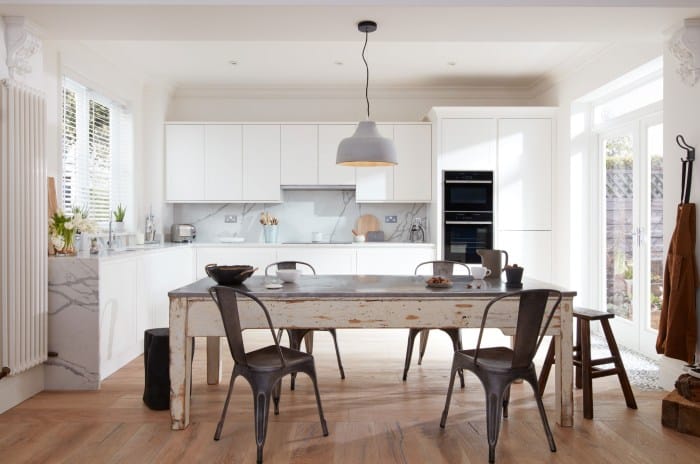The clean minimalist American classic kitchen: a sanctuary of understated elegance and timeless appeal. This design philosophy marries the practicality of classic American kitchens with the serene simplicity of minimalism. Imagine a space where functionality meets aesthetic purity, where every element is carefully considered, and where the focus is on quality materials and seamless integration. We will explore the core principles of this style, examining color palettes, materials, appliance choices, and spatial optimization techniques to create a kitchen that is both beautiful and highly functional.
This exploration will delve into the nuances of light, texture, and the strategic use of decorative elements, all while maintaining the essence of a clean, uncluttered space.
From the selection of durable, yet visually appealing countertops—perhaps a honed marble or sleek quartz—to the strategic placement of lighting to highlight key features, each design decision contributes to the overall harmonious atmosphere. We will investigate how smart home technology can be seamlessly integrated without compromising the clean aesthetic, examining efficient storage solutions and various cabinet configurations to maximize space and minimize clutter.
We’ll also compare this style to other popular kitchen designs, highlighting its unique characteristics and enduring appeal.
Defining the Style
The clean minimalist American classic kitchen represents a harmonious blend of traditional American design principles and the modern emphasis on simplicity and functionality. It avoids excessive ornamentation while retaining the timeless elegance associated with classic American aesthetics. This style prioritizes clean lines, uncluttered surfaces, and a sense of spaciousness, creating a kitchen that is both beautiful and highly efficient.The core design principles revolve around creating a sense of calm and order.
This is achieved through careful selection of materials, a restrained color palette, and a focus on streamlined cabinetry and appliances. The overall effect is one of understated sophistication, a space that is both inviting and effortlessly chic.
Color Palettes
Common color palettes for this style often feature a neutral base, allowing the natural beauty of materials to take center stage. Think creamy whites, soft grays, and subtle beige tones. These are frequently complemented by accent colors such as muted blues, greens, or warm browns, often drawn from natural elements to maintain the feeling of understated elegance. For example, a kitchen might use a base of white cabinetry with gray countertops and a backsplash featuring a subtle blue-green tile inspired by ocean waves.
Another example could involve warm beige walls, white shaker-style cabinets, and light brown wood flooring. These palettes create a soothing and timeless atmosphere.
Materials
Cabinetry in a clean minimalist American classic kitchen typically features simple, clean lines. Shaker-style cabinets, known for their flat-panel doors and simple frames, are a popular choice. Materials often include high-quality painted wood (often maple or birch) in white, cream, or light gray finishes. Solid wood cabinetry, while more expensive, adds to the overall sense of quality and durability.Countertops commonly utilize materials like quartz or marble.
Quartz offers durability and a wide range of colors, allowing for subtle veining or solid colors that complement the overall palette. Marble, with its inherent beauty and luxurious feel, is another popular choice, although it requires more maintenance. Butcher block countertops, a nod to traditional American kitchens, can also be incorporated, often as an island top, adding a touch of rustic warmth without compromising the overall minimalist aesthetic.Flooring often features wide-plank hardwood floors in light to medium tones, such as oak or maple.
These create a warm and inviting feel while complementing the clean lines of the cabinetry and countertops. Alternatively, large-format porcelain tiles in neutral tones can provide a more durable and low-maintenance option, mimicking the look of natural stone.
Style Comparisons
The clean minimalist American classic kitchen differs significantly from other styles. Compared to a farmhouse kitchen, which emphasizes rustic charm and vintage details, the minimalist style prioritizes sleekness and simplicity. Farmhouse kitchens often feature exposed beams, distressed finishes, and a more eclectic mix of materials. In contrast, the minimalist approach focuses on a cohesive and uncluttered aesthetic.In comparison to a modern kitchen, which often embraces bold colors, geometric patterns, and high-tech appliances, the American classic style maintains a more restrained and timeless approach.
Modern kitchens might utilize stainless steel extensively, while the American classic style prefers more subtle materials like brushed nickel or oil-rubbed bronze for hardware and fixtures. The American classic style retains a sense of warmth and tradition that is often absent in the stark minimalism of a purely modern design. While both prioritize functionality, the American classic style achieves it through a more refined and subtle approach.
Key Design Elements

The heart of a clean minimalist American classic kitchen lies in the careful selection and integration of appliances and fixtures. Functionality and streamlined aesthetics are paramount, creating a space that is both efficient and visually appealing. The design principles emphasize simplicity, emphasizing quality over quantity and prioritizing seamless integration of elements within the overall design scheme. This approach ensures the kitchen’s enduring appeal, reflecting the timeless elegance of classic American design while incorporating modern conveniences.
Essential Appliances
Choosing appliances for this style necessitates a focus on functionality and understated elegance. Overly ornate or brightly colored appliances would clash with the minimalist aesthetic. Instead, we prioritize sleek, integrated designs that blend seamlessly into the cabinetry. This approach maximizes visual space and maintains a sense of calm and order.
- A 30-inch built-in refrigerator, ideally featuring a panel-ready design to match the cabinetry, ensures efficient food storage without visual clutter.
- A 36-inch professional-style gas range with a minimalist control panel provides both power and visual simplicity. The choice of gas emphasizes control and responsiveness, a key element in classic cooking.
- A built-in dishwasher with a concealed control panel maintains a clean, uncluttered look. A quiet operation is crucial for maintaining the peaceful atmosphere of the kitchen.
- A built-in microwave, ideally integrated into the cabinetry, further minimizes visual distractions. Its functionality is essential, but its design should be unobtrusive.
- A single, powerful ventilation hood, ideally in stainless steel or a matching panel, ensures efficient air extraction without visual excess.
Lighting Fixtures
Lighting plays a crucial role in achieving the minimalist aesthetic. Recessed lighting provides even illumination without visual distraction, creating a bright and airy atmosphere. Pendant lights above the island or breakfast bar can add a subtle focal point, but their design should be simple and unfussy, possibly featuring a single, clean line or a simple geometric shape. Under-cabinet lighting offers task-specific illumination for food preparation, while maintaining the overall minimalist look by being discreetly hidden.
The use of LED bulbs is essential for energy efficiency and long lifespan, aligning with the modern ethos of responsible design.
Faucet Styles
The choice of faucet is significant in establishing the overall aesthetic. A well-chosen faucet can elevate the design or detract from it. The following table showcases several suitable options:
| Style | Material | Finish | Description |
|---|---|---|---|
| Gooseneck | Stainless Steel | Brushed Nickel | A classic, elegant style that offers both functionality and visual appeal. The brushed nickel finish adds a touch of sophistication without being ostentatious. |
| Bridge | Brass | Polished Chrome | A more traditional style, the bridge faucet offers a sense of timeless elegance. The polished chrome finish provides a sleek and modern touch. |
| Pull-Down Sprayer | Stainless Steel | Matte Black | Combining functionality with modern aesthetics, the pull-down sprayer offers convenience and a clean, contemporary look. The matte black finish provides a sophisticated contrast. |
| Single-Handle | Ceramic | White | A minimalist design that seamlessly integrates into the kitchen’s overall aesthetic. The white finish adds a touch of brightness and complements the clean lines of the kitchen. |
Smart Home Technology Integration
Integrating smart home technology can enhance the kitchen’s functionality without compromising its minimalist aesthetic. Concealed smart appliances, such as a smart refrigerator with an integrated touchscreen display hidden behind a panel, or smart lighting controlled via a centralized system, maintain a clean look. Voice-activated controls for appliances and lighting, while not visually apparent, offer convenience without disrupting the minimalist design.
The key is to prioritize seamless integration and avoid overt displays of technology. For example, a smart oven with a hidden control panel integrated into the cabinetry maintains a streamlined aesthetic while offering advanced cooking features.
Space Optimization and Functionality

The American Classic kitchen, even in its minimalist form, demands careful consideration of space and functionality. Efficiency is key; every square foot should contribute to the overall ease and pleasure of cooking and preparing food. A well-designed minimalist kitchen prioritizes streamlined workflows, intuitive storage, and a sense of spaciousness despite a potentially compact footprint. This is achieved through a combination of clever layout planning, thoughtful storage solutions, and a deliberate selection of cabinetry and appliances.
Optimizing space in a minimalist kitchen isn’t about cramming in more, but rather about maximizing the utility of what’s already there. This involves strategic placement of key elements to create an efficient work triangle – the imaginary line connecting the sink, stove, and refrigerator. Minimizing unnecessary movement between these three points significantly improves workflow and reduces fatigue. Additionally, the principles of Gestalt psychology, which focus on visual perception, can be applied to create a sense of spaciousness, even in smaller kitchens.
Strategic use of light and color, for instance, can visually expand the space.
Sample Kitchen Layout for Space Maximization
A highly functional minimalist kitchen layout often features a linear or L-shaped configuration. A linear kitchen, ideal for smaller spaces, places the sink, stove, and refrigerator in a straight line along one wall. This arrangement is simple, efficient, and easy to clean. An L-shaped layout offers a more spacious feel, providing additional counter space and the possibility of incorporating an island for extra preparation or seating.
In either configuration, maximizing counter space is paramount. Deep counters and a well-planned backsplash allow for ample workspace without visual clutter. Furthermore, utilizing the vertical space with tall cabinets and open shelving strategically complements the horizontal workspace.
Efficient Storage Solutions for Minimalist Kitchens
Efficient storage is the backbone of a minimalist kitchen. The goal is to keep everything neatly concealed, yet readily accessible. Pull-out drawers and shelves, rather than deep cabinets, are key. These allow for full visibility and easy access to all items. Additionally, utilizing vertical space with tall, narrow cabinets and overhead storage is crucial.
This prevents visual clutter and makes better use of the available space. Consider using tiered trays and dividers within drawers and cabinets to further organize items and maximize space. The principles of “poka-yoke,” or mistake-proofing, can also be applied here, with clear labeling and organization systems to prevent items from becoming misplaced or lost.
Pantry Storage Integration Strategies
Pantry storage can be seamlessly integrated into the overall design of a minimalist kitchen. A dedicated pantry, if space allows, provides ample storage for dry goods and less frequently used items. However, even in smaller kitchens, clever pantry solutions can be implemented. Built-in pantry cabinets, often integrated into the main cabinetry run, offer a clean and streamlined look.
Pull-out pantry units, with adjustable shelves, are particularly effective for maximizing space and visibility. Alternatively, a narrow, tall pantry cabinet can be incorporated into a corner or unused space. Remember, the key is to maintain visual consistency and to avoid bulky, standalone pantries that disrupt the minimalist aesthetic.
Cabinet Configurations for Space Optimization
Several cabinet configurations contribute to a clean, minimalist aesthetic while maximizing space. Full-height cabinets, extending from the countertop to the ceiling, offer significant storage capacity without visually overwhelming the space. Frameless cabinets, with concealed hinges and handles, create a sleek and modern look, emphasizing clean lines. Integrated appliances, such as refrigerators and ovens, further contribute to a seamless and uncluttered appearance.
Consider using a combination of closed cabinets for concealing items and open shelving for displaying select items, such as cookbooks or decorative bowls. This creates visual interest while maintaining the overall minimalist feel. The use of consistent materials and finishes throughout the cabinetry further enhances the clean, cohesive design.
Visual Appeal
The visual appeal of a clean minimalist American classic kitchen hinges on a carefully curated balance of color, texture, and light. These elements work in concert to create a space that is both aesthetically pleasing and functionally efficient, reflecting the core principles of the design style. The strategic use of these elements transforms the kitchen into a haven of calm and understated elegance.
The interplay of color, texture, and light significantly impacts the perceived spaciousness and overall mood of the kitchen. Neutrals, natural materials, and strategic lighting choices contribute to the feeling of openness and serenity characteristic of minimalist design. The following sections detail how these elements contribute to the desired aesthetic.
Color Palettes and Textures
A successful clean minimalist American classic kitchen employs a restrained color palette, often leaning towards a monochromatic scheme or incorporating subtle variations within a limited range of hues. Imagine a mood board featuring shades of creamy white, off-white, and warm greige for the cabinetry and walls. These colors create a sense of airy spaciousness and timeless elegance. The textures would be equally understated.
Consider the smooth, matte finish of Shaker-style cabinets contrasting with the subtle grain of a light oak butcher block countertop. The countertop’s texture introduces a natural warmth without disrupting the overall minimalist aesthetic. A honed marble backsplash adds a touch of luxurious texture, its subtle veining adding visual interest without being overly busy. The floors might be wide-plank light oak, offering a warm, natural texture underfoot, while maintaining a clean and uncluttered appearance.
The subtle variations in color and texture create visual interest without overwhelming the senses.
Natural Light and Minimalist Aesthetics
Natural light is paramount in achieving the airy and uncluttered feel of a minimalist kitchen. Large windows, strategically placed skylights, or even glass-paned cabinet doors maximize the penetration of natural light. The way light interacts with the chosen materials—the subtle sheen of the marble backsplash, the warm glow on the oak countertop—adds depth and dynamism to the space.
Maximizing natural light reduces the need for artificial lighting, further contributing to the clean and uncluttered aesthetic. This also reduces energy consumption, aligning with the environmentally conscious aspects often associated with minimalist design. The impact of natural light on the perceived size of a room is well documented, and it’s crucial in smaller kitchens to create a sense of spaciousness.
Backsplashes and Wall Treatments
Backsplashes and wall treatments play a critical role in maintaining the clean lines and uncluttered look of a minimalist kitchen. A simple, seamless backsplash—perhaps a large, single slab of honed marble or a subtle, textured tile in a neutral color—creates a clean backdrop for the work area. Avoiding busy patterns or highly contrasting colors is essential. Wall treatments should be equally understated.
A simple coat of matte paint in a soft, neutral shade will create a calm and uncluttered background. Alternatively, a textured plaster finish could introduce subtle visual interest without sacrificing the minimalist aesthetic. The key is to choose materials and finishes that are simple, elegant, and easy to clean, reflecting the practical functionality central to the design.
Subtle Decorative Elements
While minimalism emphasizes simplicity, a few carefully chosen decorative elements can add personality without compromising the overall aesthetic. A single, statement piece of art—a minimalist print or a simple ceramic vase—can add a touch of individuality. Consider a carefully curated collection of functional items displayed on open shelving, ensuring they are cohesive in style and color. However, restraint is key; too many decorative items will disrupt the clean lines and sense of order that defines the style.
The focus remains on the inherent beauty of the materials and the functionality of the space, with decorative elements acting as subtle accents rather than focal points.
Illustrative Examples

The following examples showcase the versatility of the clean minimalist American classic kitchen style, demonstrating how different material choices and layout strategies can achieve a cohesive and aesthetically pleasing result while maintaining functionality. These designs highlight the balance between simplicity and warmth, characteristic of this design aesthetic.
Kitchen Design Variations
Three distinct kitchen designs illustrate the adaptability of the clean minimalist American classic style. The first emphasizes Shaker-style cabinetry, the second highlights the use of a large island, and the third showcases a more open-plan integration with adjacent living spaces. These variations demonstrate the flexibility inherent in the style, allowing for customization based on individual needs and preferences.
Shaker-Style Cabinetry and Natural Stone Countertops
This design features simple, clean-lined Shaker-style cabinetry crafted from light-colored oak. The Shaker style, with its flat-panel doors and minimal hardware, is a hallmark of American classic design. The cabinets are complemented by countertops of honed Carrara marble, whose subtle veining adds visual interest without overwhelming the minimalist aesthetic. The marble’s cool, smooth surface contrasts beautifully with the warm tones of the oak, creating a balanced and sophisticated atmosphere.
Integrated appliances maintain the streamlined look, and brushed nickel hardware provides a subtle, understated elegance. The overall effect is one of timeless sophistication and understated luxury.
Large Island as Central Focal Point
In this design, a substantial island serves as the central hub of the kitchen. The island, crafted from a single slab of quartz, offers ample workspace and seating. The quartz’s durability and resistance to staining make it a practical choice for a high-traffic area. The surrounding cabinetry is made from white-painted wood, maintaining the clean lines of the minimalist style.
Stainless steel appliances are seamlessly integrated, further enhancing the clean aesthetic. Simple, bar-style pulls in a brushed stainless steel finish add a touch of modernism without detracting from the overall classic feel. This layout promotes efficiency and sociability, ideal for entertaining or family gatherings.
Open-Plan Kitchen with Integrated Living Space
This design seamlessly integrates the kitchen with the adjacent living area, creating a spacious and airy feel. The cabinetry, constructed from painted maple, is kept simple and uncluttered, with recessed handles for a flush, streamlined appearance. The countertops are made from a light-colored quartz, mimicking the look of natural stone without the high maintenance. The appliances are carefully selected to complement the minimalist aesthetic, with integrated ovens and refrigerators that maintain a seamless appearance.
The use of pendant lighting over the island adds a touch of warmth and sophistication. This open-plan design maximizes natural light and creates a sense of flow between the kitchen and living areas, promoting a feeling of spaciousness and ease.
Natural Materials: Creating Warmth and Minimalism
The strategic incorporation of natural materials is crucial in achieving the warmth often desired in a minimalist setting. The inherent texture and subtle variations in color found in wood and stone counteract the potential sterility of a purely minimalist approach. For example, the use of wide-plank oak flooring introduces organic warmth, while honed limestone countertops add visual depth and a sense of quiet elegance.
These natural elements bring a sense of grounding and authenticity, preventing the space from feeling cold or impersonal.
Hardware Selection: Impact on Aesthetic
The seemingly insignificant detail of hardware significantly influences the overall aesthetic. Simple, understated knobs and pulls in brushed nickel, matte black, or polished chrome can complement the minimalist design. Overly ornate or decorative hardware would clash with the clean lines of the style. The choice of hardware should reflect the overall tone – a brushed nickel finish suggests a more traditional feel, while matte black lends a touch of modern sophistication.
The key is consistency; maintaining a uniform style of hardware throughout the kitchen creates a sense of unity and visual coherence.
Countertop Materials: Visual and Functional Considerations
The selection of countertop material impacts both the visual appeal and functionality of the kitchen. Marble, with its elegant veining and cool tones, adds a touch of luxury and sophistication, but requires more maintenance. Quartz, a more durable and low-maintenance alternative, offers a similar aesthetic with increased practicality. The choice depends on individual priorities; those seeking a more luxurious, high-maintenance look might choose marble, while those prioritizing practicality and ease of care might opt for quartz.
Both materials, when used appropriately, can contribute to the clean minimalist American classic style.
Last Recap

Ultimately, the clean minimalist American classic kitchen represents a sophisticated blend of form and function. By carefully considering the interplay of color, texture, light, and carefully chosen materials, one can create a kitchen that is both visually stunning and remarkably practical. The result is a space that transcends fleeting trends, offering a timeless and calming environment where culinary creativity can flourish.
The key is to embrace simplicity, prioritize quality, and allow the inherent beauty of the materials and the thoughtful design to speak for themselves. This approach results in a kitchen that is not only aesthetically pleasing but also reflects the owner’s refined taste and appreciation for enduring style.
FAQ Section
What are some budget-friendly options for achieving a minimalist look?
Opt for affordable yet durable materials like laminate countertops and shaker-style cabinets painted in a neutral color. Prioritize functionality over expensive features, and consider DIY projects like painting cabinets or installing open shelving.
How can I incorporate personality into a minimalist kitchen without cluttering it?
Introduce personality through subtle details: a unique piece of art, a statement pendant light, or a collection of vintage cookbooks displayed on open shelving. Choose items with clean lines and a neutral color palette to maintain the minimalist aesthetic.
What are some sustainable choices for a clean minimalist American Classic kitchen?
Consider using reclaimed wood for cabinetry, bamboo countertops, or recycled glass backsplashes. Opt for energy-efficient appliances and low-VOC paints to minimize environmental impact. Sourcing locally made materials can also reduce carbon footprint.
How do I maintain the cleanliness of a minimalist kitchen?
Regular decluttering is key. Minimize countertop clutter, and utilize efficient storage solutions. Choose easy-to-clean materials and surfaces, and establish a cleaning routine to maintain the space’s pristine appearance.
